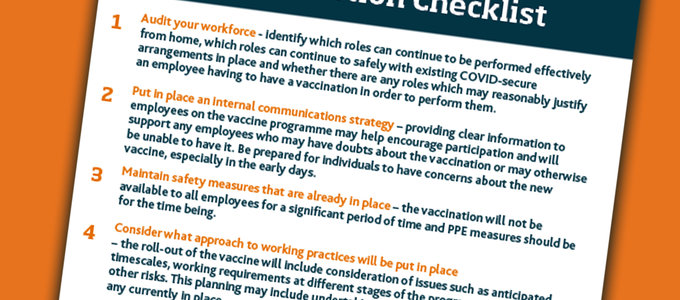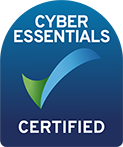Employers - COVID Vaccine Brings New Challenges – 8-Step Action Checklist


As the vaccine is rolled-out, Employment Solicitor, Sejal Patel, considers the various opportunities and challenges it presents for employers. The introduction of the COVID-19 vaccine will offer employers the opportunity, in time, to bring employees back to the workplace. Ultimately, this should mean social distancing and other PPE measures can be reduced or removed. But of course, there will be many challenges and new issues that employers will need to address.
When will the vaccine be available?
The Joint Committee on Vaccination and Immunisation (JCVI) is advising the government on how to prioritise the roll-out of the vaccine. Those most at risk of dying of COVID-19 are top of the priority list and age is being used as a key deciding factor: https://www.gov.uk/government/publications/priority-groups-for-coronavirus-covid-19-vaccination-advice-from-the-jcvi-2-december-2020#history). Further, the scale of the vaccination programme will mean that it is likely to be many months before the vaccine is widely available to the population as a whole. Boris Johnson talks about it being in the Spring, or after Easter for the majority of us to receive our jab.
The impact on an employer’s health and safety duties?
Employers have a general duty to ensure the health, safety, and welfare at work of all their employees. Employers will therefore need to consider how the availability of a vaccine impacts on this duty over the coming months.
Risk assessments:
Organisations have already undertaken risk assessments of the COVID-19 transmission risk within the workplace. There will be pressure to revisit these to assess whether any ‘COVID-secure’ measures may be relaxed or dispensed with once part of the workforce is vaccinated. This will be crucial for organisations where key activities have not been possible or have been substantially limited by having to undertake them in a ‘COVID-secure’ way.
Using vaccinated staff:
However, it is simply too early to say how effective a partially vaccinated workforce might be reflected in an organisation’s COVID-19 risk assessment and its combination of risk controls to reduce transmission. In particular, it is currently unclear if vaccination will prevent the vaccinated person transmitting COVID-19 to those that are not vaccinated. ‘COVID-secure’ measures are therefore likely to be required for some time. However, some advanced planning might be given to whether, e.g., the vaccinated employees could be utilised to undertake essential tasks which have not been possible for business reasons.
Once the vaccine is available, can employers require employees to be vaccinated?
Requiring an entire workforce to be vaccinated will be legally and ethically difficult to achieve. The government is not currently introducing legislation to make the vaccination compulsory and therefore it will be for individuals to decide whether or not they wish to be vaccinated.
Without any statutory obligation to make vaccination compulsory, employers who want to make the vaccination mandatory for their employees will need to look to other means, for example, by introducing a specific provision in the contract of employment. This may be possible for new recruits but for existing employees, employers may want to seek to rely on the requirement to be vaccinated as a lawful and reasonable instruction.
Discrimination:
A number of employment law challenges this could raise include potential discrimination issues (on the grounds of disability, age, and/or religion/belief) and potential breaches by the employer of their implied duty of trust and confidence which could result in claims for constructive unfair dismissal.
- Example: do not ask all employees over the age of 50 to be vaccinated, or all people who are known to have diabetes or other medical condition, or all those who live in a Tier 4 zone – all discriminatory thinking should be avoided.
However, there is also a human rights argument connected to an employee’s right to respect for their private life. Therefore, a blanket requirement on an entire workforce to be vaccinated is unlikely to be enforceable:
-
Example: an employer who physically attempts to vaccinate an employee could face criminal proceedings for assault.
What else can employers do?
Analyse roles and tasks:
In the early stages of the roll-out, employers may want to audit the workforce to identify which roles can continue to be done from home and which roles can continue to be performed safely with existing COVID-secure arrangements in place. Then employers can identify whether there are any roles which might reasonably justify an employee with their consent, having to have a vaccination in order to be able to perform them.
-
Example: you may want to avoid situations where vaccinated staff are put to a disadvantage compared to their unvaccinated counterparts (e.g., being given additional duties or having fewer opportunities to work remotely).
Those who refuse to be vaccinated:
The strategy for dealing with employees who are ‘refusing to be’ or ‘cannot be’ vaccinated needs to be considered carefully. If you already have people in this group working from home, you will probably need to allow them to continue to do so for now in order to reduce their likely exposure to COVID-19 and so comply with your health and safety obligations. Likewise, where people have been working in COVID-secure premises, the COVID-secure measures should be maintained.
Extremely vulnerable employees:
Difficult scenarios will arise. For individuals designated in the clinically extremely vulnerable category, who cannot work from home but cannot be brought back to work safely even with COVID-secure measures, having the vaccination would potentially allow them to return to work safely.
If you are left with roles where you cannot comply with health and safety requirements - without those people being vaccinated - then you may ultimately be justified in taking disciplinary action (including dismissal) if their role cannot be altered to accommodate safe-working and there are no redeployment opportunities. Each case will need to be dealt with on an individual basis (particularly where discrimination issues might arise) and you should seek legal advice in these circumstances.
As more people are vaccinated and the consequences of vaccination are better understood, employers will want to start to reduce COVID-secure measures. We would expect that the government will give guidance on when this can begin which will mean that it becomes reasonable for employers to expect employees to be vaccinated and/or that herd immunity may be sufficiently well-established so that risks for those who are not vaccinated are acceptably low. However, it is difficult to predict when this might happen and it could be many more months, especially as more virulent, new variants of Covid-19 are being identified, which will also have the effect of delaying the return of employees back into the workplace for: a) fear of catching a new strain; or b) existing vaccines are unproven in the fight against them.
-
Example: a non-vaccinated older Tier 4 employee may have more justification not to return to the workplace for fear of catching a new Covid-19 variant than a younger Tier 1 employee. However, an employer cannot discriminate.
Consultation is the key:
-
As you can’t discriminate, and you can’t implement a one-size-fits-all solution either, the most effective way to encourage employees to be vaccinated is through effective consultation. Consult with employee representatives and trade unions as well as with the employees themselves. Provide unbiased information about the vaccine from a credible source and offer employees the opportunity to discuss any concerns they may have with an independent medical adviser.
What can employers do if employees do not want or cannot have the vaccine?
There will be employees who are unable or unwilling to have the vaccine. This may be because of a medical condition that prevents them from being vaccinated, it may be for religious reasons or a philosophical belief, or they may have concerns about the safety of the vaccination or a phobia of needles.
Taking disciplinary action against such employee is risky and could amount to discrimination and/or a constructive unfair dismissal scenario. However, if such employees cannot be safely brought back to do their job and no reasonable alternatives are available then it may be possible to achieve a fair dismissal although obtaining legal advice would be crucial as any such actions are going to be difficult to justify in the short to medium term of the vaccine roll-out.
COVID-19 Passports - How can an employer find out if an employee has been vaccinated?
The NHS will issue ‘vaccine cards’ to remind those receiving the vaccine to present for their second dose and medical records will record if someone has received the vaccine. The government is not currently planning to issue ‘COVID-19’ passports to identify those who have had the vaccine, but this is likely to change. Employers are free to ask their employees to provide evidence of their vaccination however you need to be conscious that this will constitute a special category data and the request will need to be processed accordingly under the GDPR. There will be also be potential issues around privacy, unfair treatment/discrimination, and falsified documentation that employers will need to address.
Vaccinated vs non-vaccinated and managing ‘reluctant returners’
At the moment, your COVID-secure working arrangements and PPE should remain in place along with adhering to government guidance. The pandemic will be with us for some considerable time therefore employers should plan for COVID-19 being an ongoing issue despite the vaccine.
Further, even employees who have been vaccinated may still not be comfortable with returning to their workplace. Employers should consider how to manage any ‘reluctant returners’, as well as how to manage a potentially mixed workforce of those who have been vaccinated and those who have not yet come through the vaccine programme or have not otherwise had the vaccine.
- Covid-19 Vaccinations and the Workplace – see our
Employer Workplace Action Checklist
setting-out the 8 main steps and considerations for employers
If you have any questions about how these developments (or any other COVID-19 measures) will affect your business, please contact contact us here.
View all

